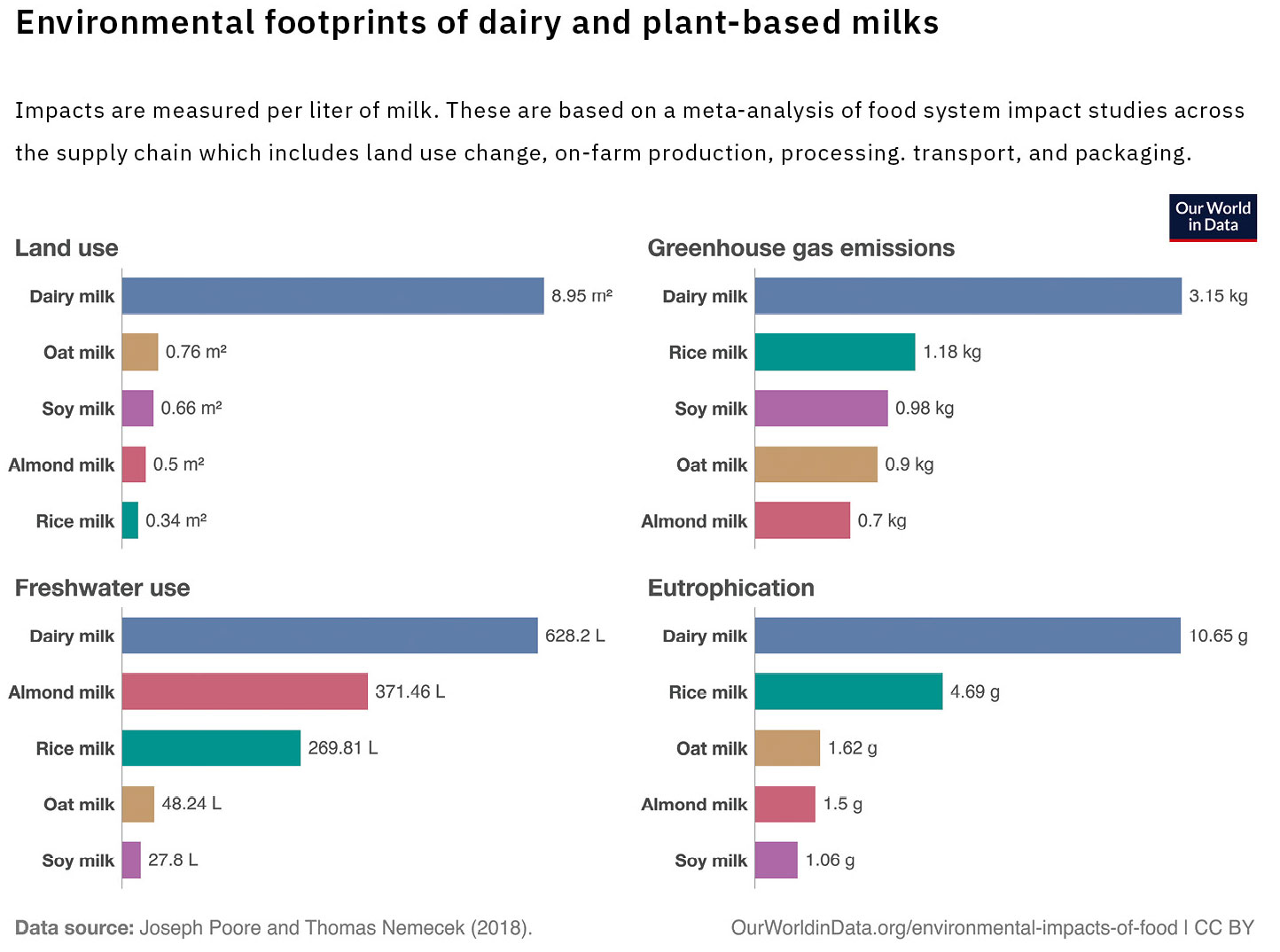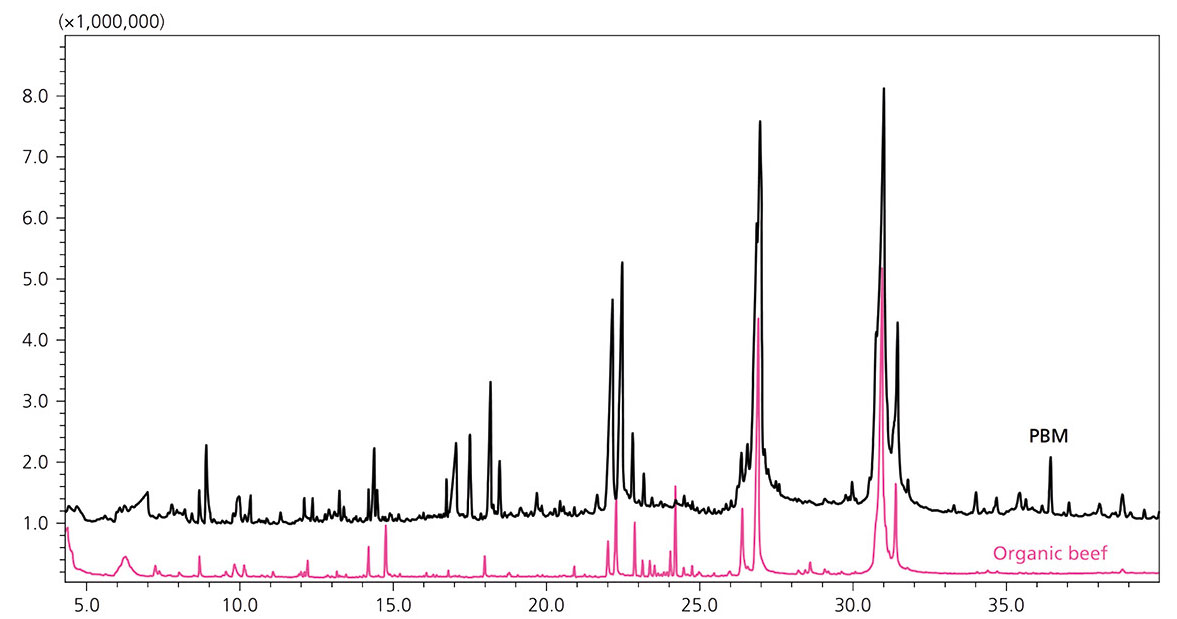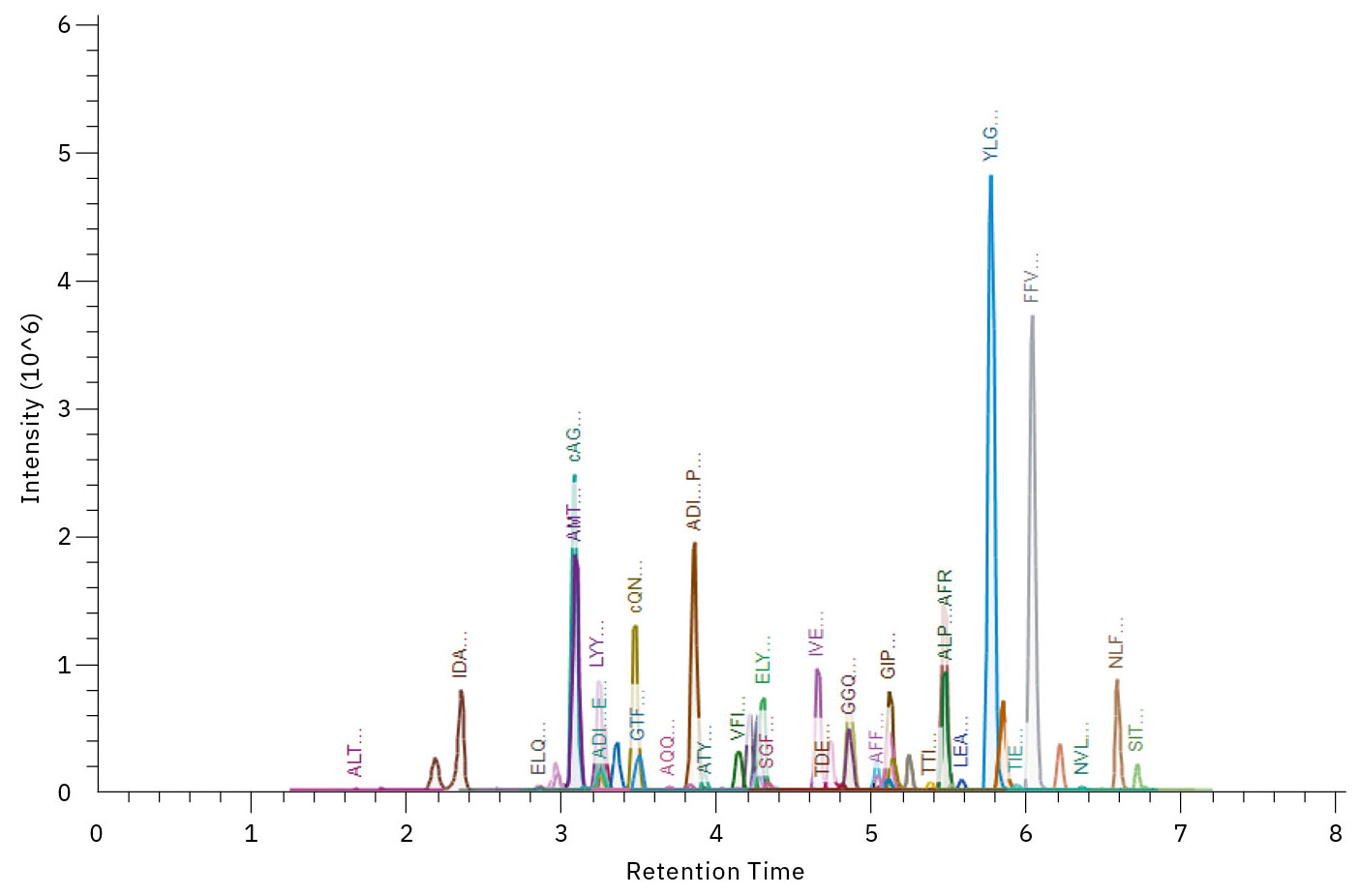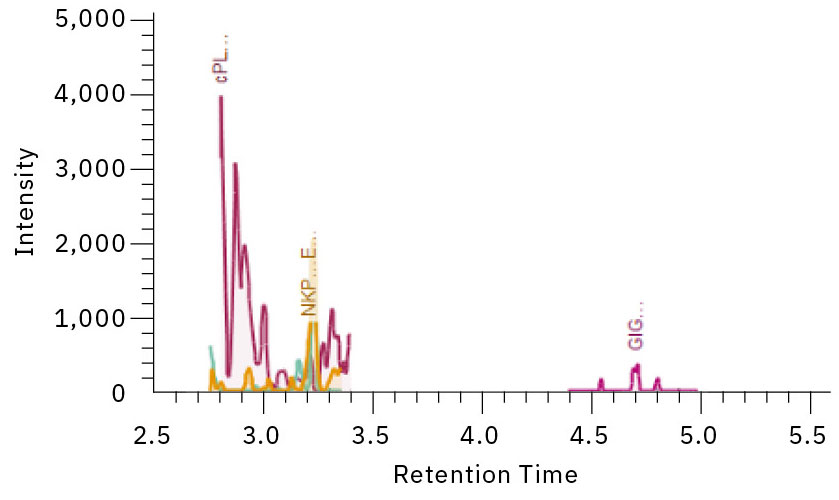
Giving the future
a familiar taste
The science behind making plant-based meats (PBMs) as good as the original
Dr. Jan Peter Mayser, Shimadzu Europa GmbH
New products often only gain acceptance by emphasizing how much they resemble older products. This applies in particular to conceptually innovative or disruptive products. A classic example is the automobile, which was originally called the “horseless carriage” to make it seem familiar – even though it was actually a revolutionary new invention that would change the world forever.
One of today’s innovative new products are plant-based alternatives to meat. The potential market is huge, as these new foods address issues and concerns ranging from personal health and ethics to food security and the environment. So companies are investing heavily in giving these new foods the look, feel, smell, taste and texture of real meat as well as in meeting various other regulatory and consumer demands. How exactly are they doing all that?
Plant-based meats (PBMs) are becoming increasingly popular. More and more consumers are opting to go meat-free, whether out of concerns for animal welfare, personal health, their carbon footprint or in support of more sustainable agricultural practices (Figure 1). Or perhaps because of all of the above: By reducing or eliminating meat from their diets, individuals can decrease their risk of chronic heart disease and cancer, help mitigate deforestation and greenhouse gas emissions associated with the livestock industry and align their values with a more compassionate approach to food consumption.

They can also help ensure global food security. Not only is the world’s population rising, but numerous climate-related and other factors are expected to affect how well we will be able to feed one another in the years ahead. Meat alternatives offer the potential to feed a growing population by using our limited resources more efficiently, since meat and animal-based proteins require more resources per kilogram to be produced than plant-based alternatives. To put it another way: Expanding the development of plant-based meats satisfies many different appetites.
Gaining acceptance through analysis
Despite the many reasons why a consumer might desire to buy a plant-based meat substitute, whether they actually do so will depend on several factors. For instance, further increasing the popularity of plant-based alternatives requires that these foods better imitate their traditional meat counterparts. At the same time, plant-based foods must be reliably tested in areas ranging from protein and fat content to the presence of pesticides, herbicides and allergens.
If the goal is to increase consumer acceptance and expand the safe commercialization of these new foods, the means to do that are to be found in expert analysis by qualified people and quality instruments. At the end of the day, success can only come by testing and measuring how well and how safely a particular PBM food formulation resembles the meat-based product it is intended to replace.
Sensory testing: The human touch
One of the ways that manufacturers of PBMs use to ensure that their products replicate the end-user experience of real meat is sensory testing. Human sensory evaluation involves the testing of a product’s sensory characteristics by trained panelists. Characteristics of interest include appearance, aroma, taste and texture. Panelists are trained to use their senses to objectively evaluate the sensory attributes of a product and provide feedback on its overall quality. For plant-based meat alternatives, sensory testing is important, as it provides information on how the product will be perceived by consumers. By obtaining feedback from a panel of trained sensory evaluators, manufacturers can make adjustments to improve the user experience of their PBMs.
One common method of sensory testing is discrimination testing, where panelists are asked to compare two or more samples of plant-based meat alternatives and determine if they can detect any differences between them. Another type of sensory testing is descriptive analysis, where trained panelists are asked to rate the intensity of specific sensory attributes in a product, such as saltiness, umami (savoriness) or juiciness. A third type – consumer testing – involves asking a group of consumers to taste and evaluate a product and provide feedback on its sensory characteristics.
These types of testing help manufacturers to understand the sensory profile of their products as well as consumer preferences and to identify any sensory differences between their products and real meat. They then use the results to make adjustments to their products to better replicate the sensory experience of real meat and to better meet consumer expectations.
Sensory testing by expert instruments
In addition to testing by human experts, sensory testing is also being carried out by precision lab instruments. Figure 2 shows an example of sensory testing by instrumentation in which a plant-based meat is compared with an organic beef sample. A gas chromatograph is obtained for each of the samples and compared. The gas chromatograph run shows the more volatile and semi-volatile compounds within the food sample. These compounds are primarily responsible for the taste and odor structure of a food, and they have been well characterized, making it possible to clearly associate the compound with the taste or smell. The comparison of the chromatograms shows that there is already a large overlap in odor-active compounds between the samples. This suggests that they have a similar taste profile, while clear differences can still be seen. For example, Maltol is identified in the PBM. This gives the alternative meat a caramel-like, burnt aroma.1 Nonanal is identified in both samples: Its purpose is to give a citrus-like, waxy flavor.2 This analysis and sample preparation was conducted on a Shimadzu GCMS-TQ8050 NX in combination with an AOC-6000 sample preparation station (Figure 5).
Allergen testing: Safety, compliance and quality
While plant-based foods are often thought of as inherently safer than animal products, the reality is that many common allergens, such as nuts, soy and wheat, can be present in these products. Therefore, it is essential that food manufacturers conduct thorough allergen testing to ensure the safety of consumers with food allergies.
Cross-contamination: One of the primary reasons why allergen testing is crucial for plant-based meat alternatives is the risk of cross-contamination during the manufacturing process. Many plant-based meat alternatives are produced in facilities that also process allergenic ingredients, increasing the risk of accidental contamination. Without proper testing, consumers with food allergies may unknowingly consume allergens that could trigger severe reactions.
Novel ingredients: The use of novel ingredients in plant-based meat alternatives, such as pea protein or seitan, may also pose a risk for individuals with allergies to these ingredients. While they are generally considered safe for the majority of consumers, individuals with specific allergies must be cautious and rely on accurate allergen testing to determine if a product is safe for consumption.
Regulatory compliance: In addition to the safety concerns for consumers with food allergies, proper allergen testing is also essential for regulatory compliance. For instance, both the US Food Allergen Labeling and Consumer Protection Act (FALCPA) and the European Food Safety Authority (EFSA) require that food manufacturers disclose the presence of major food allergens on their product labels. Failure to accurately test for allergens and disclose this information can result in serious legal consequences for food companies.
Quality control: Allergen testing can also help food manufacturers optimize their production processes and prevent costly recalls. By implementing robust allergen testing procedures, companies can identify and eliminate potential allergen contaminants early in the production process, reducing the risk of contaminated products reaching consumers.
Cross-reactivity: Additionally, food manufacturers must also consider the potential for allergen cross-reactivity when conducting allergen testing for plant-based meat alternatives. Cross-reactivity occurs when proteins in one type of food trigger an allergic reaction in individuals who are allergic to different foods. By conducting comprehensive allergen testing, food manufacturers can identify potential cross-reactive allergens and take appropriate steps to address and label these in their products.


A new, time-saving method of allergen testing
Allergen testing for PBMs can be challenging due to their complex nature. Plant-based meat alternatives often contain a wide range of ingredients, some of which may have been processed in different ways or come from different sources. This complexity makes it crucial for food manufacturers to use a variety of testing methods, including enzyme-linked immunosorbent assay (ELISA) and polymerase chain reaction (PCR), to accurately detect potential allergens in their products.
A new method – recently developed by Shimadzu – compensates for this complexity by providing a time-saving, holistic analytical solution. Figures 3 and 4 detail how LC-MS/MS – specifically, a Nexera X2 Ultra HPLC and an LCMS-8050 – was used to check for 13 different food allergens in a single run.
The method is capable of identifying the eight allergens FALCPA recommends (milk, eggs, fish, crustacean shellfish, tree nuts, peanuts, wheat and soybeans) as well as the expanded list recommended by EFSA (gluten, milk, eggs, nuts, peanuts, soybeans, fish, crustaceans, molluscs, celery, lupin, sesame, mustard and sulphites). A total of 245 transitions were set to monitor 50 peptides selected from 21 proteins. Allergens were found in both raw foods and cooked foods, proving that the new method can identify allergens from different food matrices.

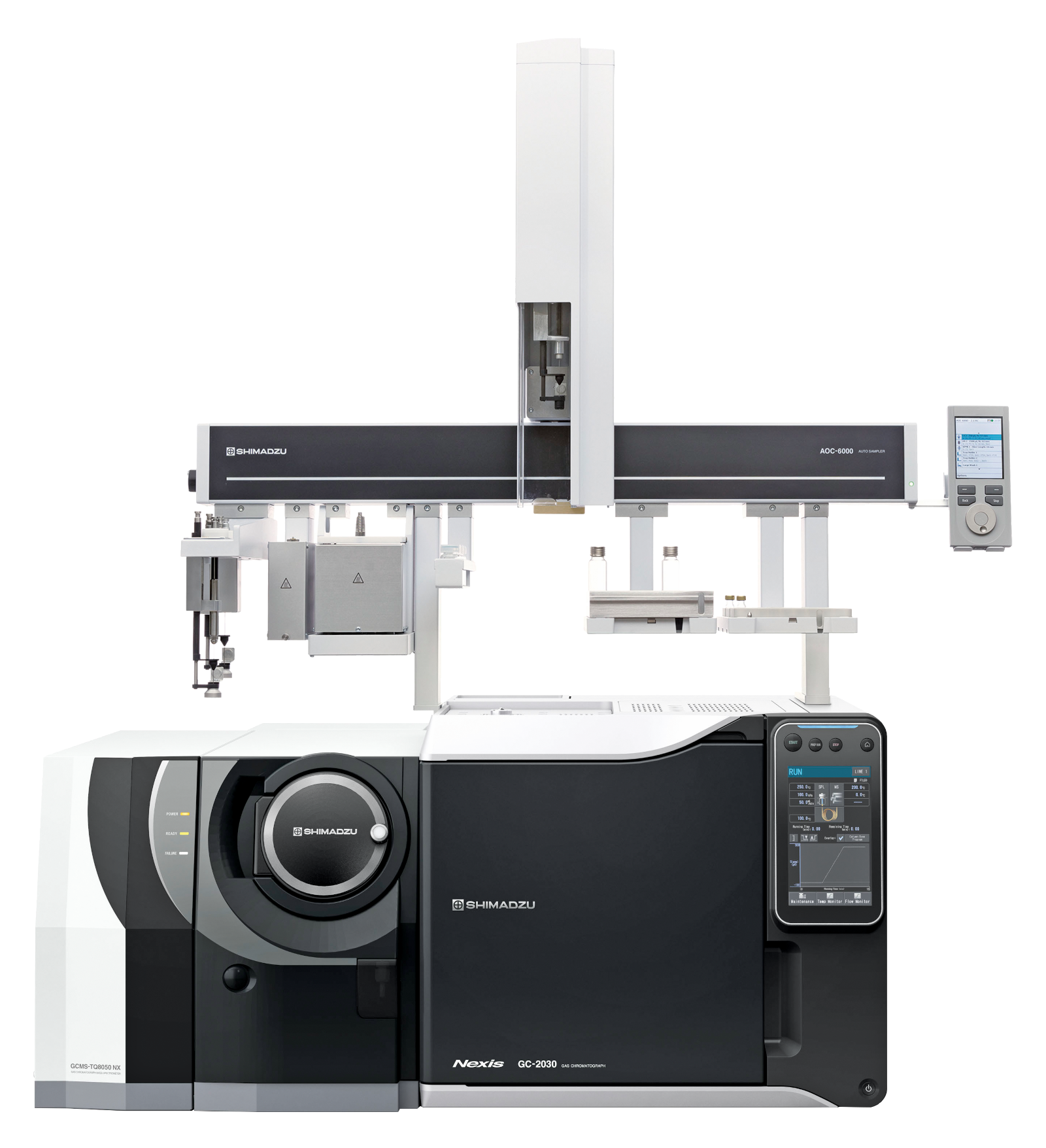
This ability to check for multiple allergens within a single run is particularly important for PBM producers. Producers need to be able to quickly and easily check for multiple allergens from multiple sources, because when developing recipes for these alternative meats, they need to combine ingredients from many different bases to achieve the desired results in taste and in smell. If something in the mix is not working right, they need to know quickly so they can adjust the recipe.
Analytical instrumentation is also used to test for composition, nutritional content and overall quality. Instrumental analysis reveals important information about the product, such as its protein content, fat content and the presence of any harmful substances. Manufacturers use these tests to ensure that their PBMs meet the desired nutritional profile and are safe for consumption. By combining these tests with others, such as sensory testing, manufacturers can look forward to a very appetizing future for their plant-based meats.
Making progress safe – and palatable
Sensory and allergen testing are just two of the many strategies being used to help expand the acceptance of plant-based alternative foods. Greater acceptance offers benefits ranging from the personal to the global level, as well as financial benefits for the companies able to meet the increasing consumer demand. Shimadzu instruments deliver the capability to fast and efficiently perform most of the necessary tests for this growing industry. We know there is a hunger and no time to waste.
Planet Earth – and humanity – will face a number of challenges in the coming years. Many say that we are already facing them today. However you look at it, the solution is simple: science. Using the best science and the best technological tools, together we can rise to meet the challenges.
Schmid, W., Grosch, W. (1986). Identifizierung flüchtiger Aromastoffe mit hohen Aromawerten in Sauerkirschen (Prunus cerasus L.). Z Lebensm Unters Forch. 182: 407–412. https://doi.org/10.5740/jaoacint.19-0060
Tairo Ogura, Robert Clifford, Uwe Oppermann, Simultaneous Detection of 13 Allergens in Thermally Processed Food Using Targeted LC–MS/MS Approach, Journal of AOAC INTERNATIONAL, Volume 102, Issue 5, 1 September 2019, Pages 1316–1329, https://doi.org/10.1093/jaoac/102.5.1316
Application Note: Evaluation of the Deliciousness of Meat Alternatives, https://doi.org/10.1007/BF01844236.
Schieberle, P., Grosch, W. (1983). Identifizierung von Aromastoffen aus der Kruste von Roggenbrot. Z Lebensm Unters Forch. 177: 173–180. https://doi.org/10.1007/BF01146791.
